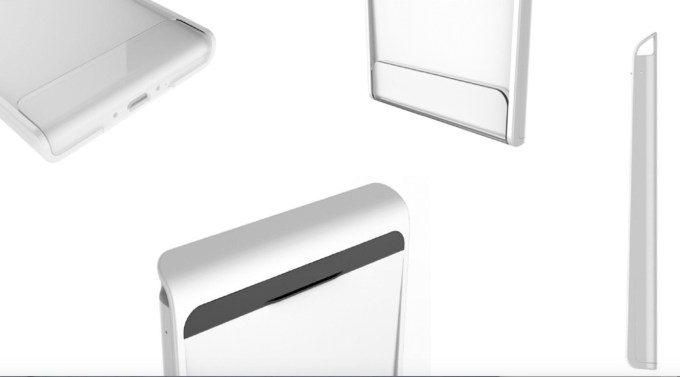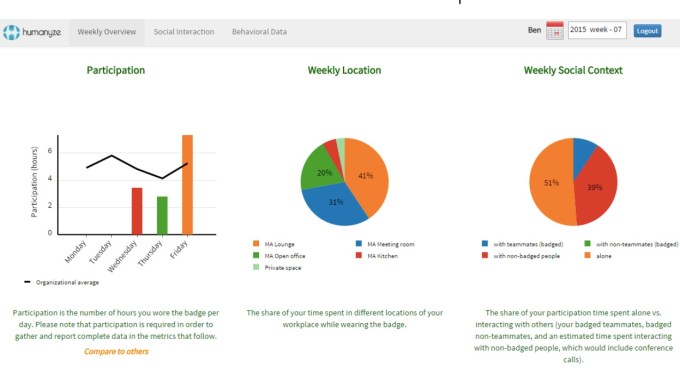Humanyze, a unique new firm spawned in the MIT Media Lab, has developed a system that uses a smart employee badge to collect employee behavioral data, which it links to specific metrics with the goal of improving business performance. It announced $1M in seed funding today.
The funding was led by Romulus Capital with contributions from Boston Seed and dunnhumby Ventures.
Humanyze president Ben Waber says while sports teams have done a great job of using data to evaluate their employees (players), business to this point has not used data effectively to measure the productivity of its workers. They may look at spreadsheets about overall business performance, charts about sales conversion rates and the number of leads generated by marketing, but they don’t look at how employees interact with one another and what impact that has on the bottom line. Waber and his co-founders began studying human behavior and its impact on business several years ago at the MIT Media Lab. They spun out the company, originally called Sociometric Solutions in 2010.
In order to measure human behavior, the founders needed to a tool to collect data, so they developed a smart employee badge with a microphone, accelerometer, bluetooth connection and other tools typically found in a smart phone. (In fact, it looks a bit like a cell phone.) It measures things like how people moved through the day, who they interacted with, what their tone of voice was like, if they leaned into listen and other types of interactions that happen at every company every day.

Humanyze smart employee badge
Before you start looking at this as the ‘Big Brother’ badge, Waber says Humanyze has taken precautions to protect privacy. First of all, it’s entirely opt-in and they write a contract with the customer and end users ensuring privacy. “It’s written into our contracts that companies don’t have access to individual data, and we sign a contract (consent form) with our end users which says we will not give individual data to anyone else. We would be in violation of our contract if we do,” Waber said
There are also technical safeguards put into place — no content is ever recorded and is analyzed immediately without ever being saved to memory, names aren’t kept in the same location as behavioral data and so forth, he explained.
Once, they had this badge, they asked early customers to give them key performance metrics such as sales or customer service completion times to compare against the data, and there was lots and lots of data.
Each badge generates about 4GB of data per day, which gets uploaded to the cloud where Humanyze breaks down the 40 types of information it collects and pares it down to the 6 most important pieces for the client. They then link that to a key business metric dashboard, so the customer can see how behaviors are affecting the bottom line performance of the company.

Once they started collecting data, they could begin experimenting to see how changing certain factors can affect the numbers doing simple A/B testing. One group gets the tweak, one doesn’t and they see what happens.
They started working with the Bank of America customer service centers, a massive operation with 10,000 employees working at locations across the world. When they began studying the reps they figured the key indicator would be how they talked to customers, but they found that it was actually how the talked to one another that was most important because employees shared information and techniques.
They learned that employees talked most during the 15 minutes their lunches overlapped, so they tried giving one group lunch all at the same time and let the other group continue to have lunch according to the old staggered schedule. What they found surprised them.
Network cohesiveness, which measures how well they communicate went up 18 percent. This reduced stress (as measured by tone of voice) by 19 percent. All of this led to happier employees and lower turnover rates, which went down 28 percent. The key metric though, call completion time improved by 23 percent. These are numbers that on a scale of Bank of America could translate into billions in savings.
He claims the company has seen similar results at other early clients, which has resulted in massive efficiency increases. It has worked so well they have been able to bootstrap to this point. In other words, big companies will pay for these kinds of results.
Waber said, the company wants to use today’s funding to hire a Chief Product Officer and other employees and to allow them to scale up by adding additional pilot partners.
It also announced Deloitte as a new partner along with two other companies it couldn’t name.
Waber sees a bright future in this. If his company can work with customers to find cost savings and efficiency increases, it could be extremely lucrative, but it needs to prove it can scale this beyond the pilot stage to a full-fledged business.
Product photos courtesy of Humanyze.
